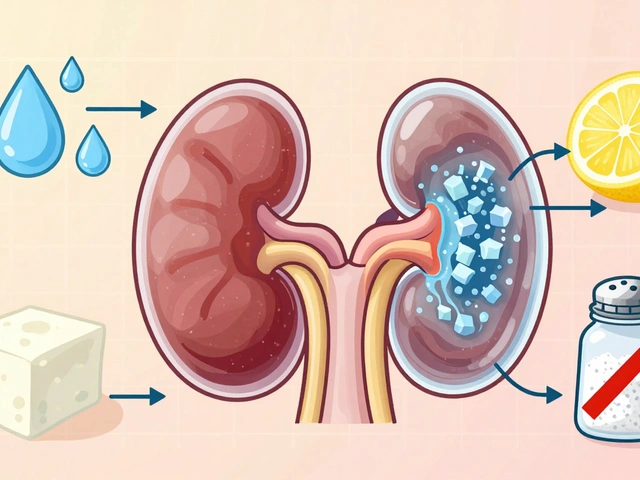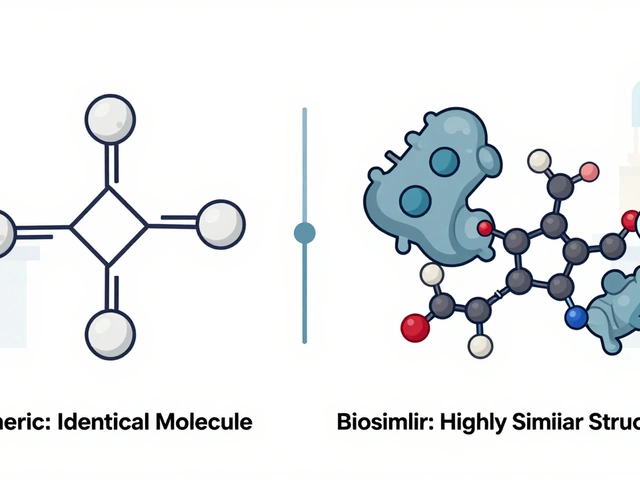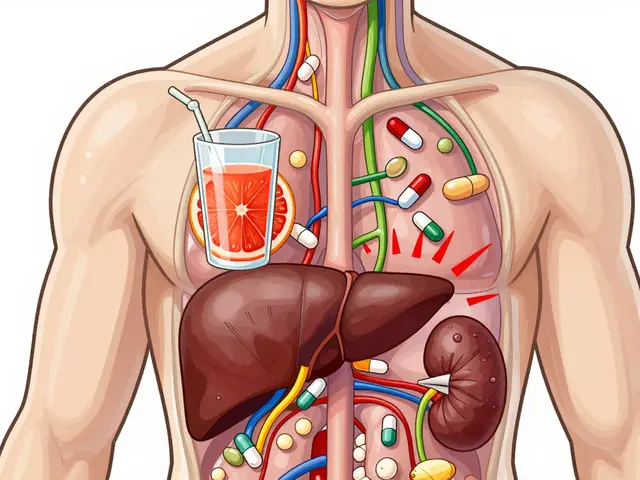If the word “Prednisone” strikes a love-hate chord, you’re not alone. People stuck with chronic inflammation—think Crohn’s, rheumatoid arthritis, or lupus—know this steroid can feel like a superhero for symptoms, but turns into a supervillain when the side effects barge in. Moon face, weight gain, raging hunger, insomnia, mood swings—the joke’s on anyone who thinks those are small trade-offs. With millions desperately searching for a safer plan, what’s actually working as a Prednisone replacement when you want real relief without paying for it in spades?
Budesonide: A Targeted Approach With Less Baggage
Budesonide came marching onto the scene as a sort of local fire extinguisher, especially for gut and lung problems. It’s a cousin of Prednisone, but it acts differently—it works hard in the tissues it lands on and doesn’t swirl around your bloodstream as much. That’s a big deal for folks dealing with Crohn’s, ulcerative colitis, or asthma. The idea is simple: punch out inflammation hard where it matters most, but don’t set off alarm bells everywhere else in your body.
The numbers speak for themselves. In a huge multicenter trial in Europe, people with mild-to-moderate Crohn’s fared almost as well on budesonide as those on Prednisone but without the wild side effects. Around 6 in 10 got better in eight weeks using budesonide, and clinical relapse was less of a constant threat. People usually didn’t get the same puffy faces, brittle bones, or adrenal crashes that shadow Prednisone users. And practically, budesonide hits the digestive tract hard but mostly sidesteps the rest of your body—just the gut, not your sleep or waistline.
You won’t get off scot-free, though. Budesonide can still suppress your immune system—colds and infections can mess up your plans, especially if you’re already run down. Occasional headaches and nausea are on the table too. But when you compare the two, budesonide feels like the steroid you’d actually want to be stuck with, assuming your inflammation isn’t off the charts or in an organ budesonide can’t reach. For chronic asthma, the story’s similar: inhaled budesonide keeps things under control with far less risk of the bone thinning and weight issues that put Prednisone on your personal blacklist.
Quick tip if you’re already on Prednisone and want to switch: Always talk to your doctor, because steroids demand slow, stepwise tapers—dropping them cold-turkey is like yanking out wires from an engine while it’s running. Budesonide’s not for everyone, but if your issues start in the gut or airways, it’s a serious contender—cheap, well-tested, and way easier to live with day to day.

Methotrexate: A Heavy Hitter Without the Steroid Luggage
This old-school drug started life fighting cancer, but stepped into the autoimmune scene for people needing heavy-duty long-term help. Methotrexate tamps down your immune system by messing with folate—it puts the brakes on the cells causing all the damage. Unlike steroids, it doesn’t boost your appetite or send you on a mood rollercoaster, but you won’t be wolfing down potato chips at midnight or lying awake from steroid energy surges either.
Methotrexate wins big points for chronic stuff like rheumatoid arthritis, psoriasis, and even some forms of lupus. Over time, it keeps joint pain and swelling from boiling over, lowers the need for rescue steroids, and helps people actually hang onto their quality of life. You usually take it once weekly, so you’re not popping pills every day. The research is solid, too: a major review found it can dial back symptoms as well as steroids, especially after the first few months, without the weight gain and bone risks that make steroids a nightmare.
The hitch? It’s not a walk in the park. Methotrexate can roast your stomach (think nausea, mouth ulcers, even some hair thinning). Liver checks are non-negotiable—if you like your whiskey or have liver issues, you’ll want to keep a close eye on blood tests. You also need to dodge infections, since your immune system will slow down. And guys, methotrexate can mess with sperm count temporarily, while anyone able to get pregnant should run a mile during treatment—birth defects are a real risk.
Most people combine methotrexate with folic acid, which lessens some nasty side effects. As for tips—don’t take it after a boozy Friday night, spread out your fluids, and tell your doc about every med you’re taking, because a lot of drugs clash with methotrexate. If you’re thinking of ditching steroids but your body’s in full attack mode, this drug’s a classic backup that, while not free of headaches, usually saves you from the biggest steroid dramas.

Biologics: The Pinpoint Specialists
If steroids are sledgehammers, biologics are sniper rifles—high price tags, but pinpoint focus. These lab-made antibodies zero in on the exact molecules fueling your body’s meltdowns. Drugs like adalimumab (Humira), infliximab (Remicade), and etanercept (Enbrel) have changed the whole autoimmune scene, letting loads of people thrive who once faced wheelchairs or back-to-back flare-ups. You get these by injection or IV, not as pills, and they can target everything from gut to joints to skin.
The beauty? Biologics barely touch your hormones or metabolism. No “moon face,” no steroid psychosis or insomnia, no sudden burst of diabetes. Instead, they kick your disease into remission and, sometimes, let you drop steroids for good. Study after study over the past five years has backed them up: Crohn’s, colitis, psoriasis, ankylosing spondylitis, severe asthma, you name it—biologics are taming diseases that used to run rampant. The American College of Rheumatology keeps updating guidelines thanks to their success—sometimes people on biologics cut their steroid dose to zero within months.
Still, a few words to the wise. Biologics can set you up for infections—COVID, tuberculosis, even random sinus bugs. Some need special screening before and during treatment. Costs can be a punch in the gut, too: without insurance, a single injection can run $4,000 or more (check for copay cards and patient-assistance programs if cash is tight). Plus, these meds usually require close monitoring for liver or blood effects, and some can cause rare but serious side effects like nerve problems or new autoimmune issues.
If you’re eyeing a switch, start with a real talk with a rheumatologist or gastroenterologist—this stuff isn’t one-size-fits-all. And patience is key: biologics work slow and steady, not overnight. The impact? Upwards of 60% of people with moderate to severe Crohn’s say biologics gave them their life back within a year, often with a much lighter steroid load. It’s proof you don’t have to live on Prednisone forever if you get the right precision drug.
If you’re digging into all your Prednisone replacement options, check out the latest scoop on what’s actually available and working for real people. There’s no perfect swap—everything lands differently depending on your genes, your disease, even your insurance. But today, more people than ever are ditching decades-old steroids for drugs that fit their bodies (and lives) way better.







21 Comments
Chris Kivel
Good practical breakdown right off the bat. Budesonide being more local really changes the risk profile for a lot of people, and that alone makes it worth talking about for gut and airway problems.
Biologics are the real game changers for folks who keep getting trapped in steroid cycles - they let you taper or stop steroids in many cases and actually keep remission.)
Methotrexate still has a place as a reliable, low-tech long term option and pairing it with folic acid does remove a bunch of the nasty stuff. Monitoring is the name of the game for all these switches, bloodwork and follow-up more than once. For anyone juggling side effects, the whole goal is fewer steroid bursts and a steadier life, and that’s what these options deliver.
Vicki Roth
Solid summary, straight to the useful bits. Worth pointing out that budesonide is underappreciated because it quietly works without drama for many people. It’s not flashy but it keeps the lights on.
Also methotrexate as a weekly pill or injection is way easier logistically than being hooked to IV biologics, for some folks that’s the deciding factor when weighing real life vs clinical trial numbers.
Praveen Kumar BK
Switching meds requires planning and discipline, not panic.
sonia sodano
People act like Prednisone is some unavoidable rite of passage for autoimmune disease. It isn’t. Surgeons don’t leave staples in because they can’t be bothered to sew, and doctors shouldn’t keep prescribing systemic steroids for maintenance because they’re cheap and fast.
Methotrexate and biologics represent actual progress. The former is durable and predictable if you accept monitoring and some side effects. The latter are expensive, yes, but they change disease course in ways steroids never will. If someone is still stuck on long-term Prednisone it’s a failure of management more than pharmacology.
Insurance navigation and access are the real bottlenecks, not the lack of options. That’s the inconvenient truth people gloss over when they champion cheap steroids as the only viable route.
Garima Gauttam
Less is more
Budesonide aims local so you lose less of yourself to treatment. That’s the quiet victory here. Inflammation needs focus not fireworks.
Pat Merrill
Nice compact phrasing, that last line sticks. Patients need options that let them keep their routines, and anything that does that without wrecking sleep or mood is worth the effort.
Also the reminder about tapering is critical - abrupt stops are medical drama waiting to happen. Slow steps, steady follow up, and honest talk with the specialist are the low-key heroic moves here.
VAISHAKH Chandran
Budesonide works most times. Methotrexate is fine for long haul. Biologics are expensive but powerful.
People here want choices and India has good generics so cost arguments get weaker when quality generics exist. Use what works and monitor. No theatrics.
Viji Sulochana
Agree with the monitoring note, don’t skip tests. I missed an appointment once and that led to a minor flare, lesson learned the hard way.
Also small thing but helpful - keep a simple medicine list in your phone so every doc knows what you’re on. Makes interactions way less messy.
Vishal Bhosale
Article says most of it. Biologics are overhyped in casual threads though.
Not everyone needs fancy injections. Some people do well on older drugs with proper follow up. Save the dramatic turns for the rare cases.
Georgia Nightingale
Let me be blunt. Biologics are spectacular for many, and that’s not hyperbole.
They target exact pathways and that sometimes means remission instead of band-aid symptom control. People living with relentless flares get to reclaim actual time and function and that matters in ways lab numbers can’t fully capture. Insurance and cost are the bureaucratic villain and yes it’s infuriating when an effective drug is gated behind paperwork and co-pay hell. For those who can access them the side effects profile is still better than chronic steroid toxicity - no moon face, no brittle bones, no steroid-driven mood implosions. The screening and monitoring are annoyances but they are manageable and worth it if you value long stretches of normal days. Switching off steroids doesn’t mean immediate cure, it means getting onto a plan that aims at the root cause rather than slamming down every flare with high dose steroids. Real talk: some folks will still need short steroid bursts during surgery or bad infections, and that’s fine if those bursts are rare instead of constant. Clinicians who treat to target and use treat-to-target algorithms tend to get better outcomes than those who reflexively reach for Prednisone. Patient education matters - knowing what to expect from methotrexate, from budesonide or from a biologic avoids panic when a lab shows a tweak or an injection schedule changes. Long term, the goal is fewer steroids, fewer abrupt flares, and more predictable living. If remission is achievable with a biologic and it removes the need for chronic steroids, that is a real win that deserves the fuss it gets.
Chris Kivel
Totally agree, the patient experience piece is massive. Remission isn’t just a lab value, it’s being able to plan a vacation without steroid-induced insomnia or mood swings wrecking it.
Also worth saying that many programs now have financial aid, manufacturer support, or biosimilar options that cut costs dramatically. It’s messy but not always unaffordable. Clinicians who understand insurance pathways are underrated allies.
Praveen Kumar BK
Precision in language matters. Saying a drug "cures" when it manages is sloppy. Monitor, document, follow protocols.
Also avoid casual shorthand like "steroids are bad" without nuance. They have a place, properly used.
Garima Gauttam
Words bend reality
Calling something cure or catastrophe shapes choices and fear. Precision is useful but don’t let perfect grammar make you ignore the lived small mercies of a drug that lets someone sleep again.
Kevin Aniston
Budesonide actually does feel like a practical middle ground for a lot of people with gut or airway inflammation, and it deserves more real-world attention than it gets.
It targets tissues more than your whole body, so the steroid baggage-moon face, crazy weight swings, shattered sleep-shows up way less, which matters when you want to live a normal life instead of being a walking side effect diary. In my experience and from what I see from others, the initial response can be quick enough to stop the acute pain and diarrhea that wreck days, and the maintenance profile keeps flare frequency down without the same long-term bone or metabolic penalties.
Yes, it can still suppress immunity and cause nausea or headaches sometimes, but the balance is different. People on budesonide usually trade brutal systemic problems for milder, manageable nuisances. That trade matters when you're thinking about quality of life and long-term health rather than just short-term control.
Methotrexate sits in a different slot entirely. It’s slow to kick in but steady as a rock for chronic control, especially for joints and skin. The weekly dosing rhythm and folic acid co-prescription are small hassles compared with avoiding daily steroid swings. The liver and blood monitoring are real constraints though, and anyone with a history of liver disease or heavy alcohol use needs a clear plan before starting.
Biologics are life-changing for a ton of folks, and the lack of steroid-style metabolic chaos is a huge win. The screening and infection risk are manageable with the right follow-up and education, and many people end up tapering off steroids entirely after months on a biologic. Cost and access remain the biggest obstacles, but patient-assistance programs and biosimilars are chipping away at that problem.
Bottom line, there’s no one-size-fits-all swap, but the modern toolbox-budesonide for targeted problems, methotrexate for steady long-term control, and biologics for precision high-efficacy treatment-lets most patients move away from chronic Prednisone if they work with a specialist and stick to monitoring plans. That coordination between patient and doctor is the actual game changer, not just swapping a pill.
kiran kumar
budesonide is often slept on but it does its job good, not flashy but less drama on the body
methotrexate is heavy duty and you gotta respect the monitoring, dont be casual about it
biologics are brilliant but damn expensive and some ppl never get access
Brian Johnson
Biologics saved my mobility and cut my steroid use to zero.
Jessica Haggard
Seeing someone get off Prednisone because of a targeted alternative is always encouraging, especially when the switch is planned and monitored closely.
For folks who rely on steroids for quick flares, a staged approach that brings in methotrexate or a biologic while tapering steroids tends to produce better long-term outcomes and fewer rebound problems. Share the plan with the care team, keep up with bloodwork, and make lifestyle supports part of the package so the meds can do their job without extra chaos. Adherence and patience are underrated tools in this fight, and they matter as much as which drug is chosen.
Alan Clark
Totally agree with that staged plan and the patience piece. In the UK a lot of people see incremental improvements once biologics are started, and the psychological relief from not needing constant steroids is huge. Access can still be patchy, but when meds line up with proper monitoring, the momentum is real and recovery becomes sustainable.
Mark Anderson
Cost is the elephant in the room every single time biologics come up. Insurance and assistance programs do help, but the list prices are wild and that creates an unfair lottery for people who need these drugs.
It’s important to be blunt about this because medical benefit design shapes real choices. Advocacy for better pricing, wider biosimilar adoption, and streamlined prior authorization processes would move a lot of people off steroids faster. Clinicians can help by documenting functional gains and pushing hard on approvals when the data supports a biologic over chronic steroid exposure.
Shouvik Mukherjee
Adding to the cost point, patient support programs and local NGO resources can be surprisingly helpful in bridging gaps if someone is proactive and has the right referrals. Also clinic social workers are underused allies who can cut through red tape quietly and fast.
G.Pritiranjan Das
Folic acid with methotrexate really reduces the nausea and mouth sores, worth mentioning for anyone starting it.